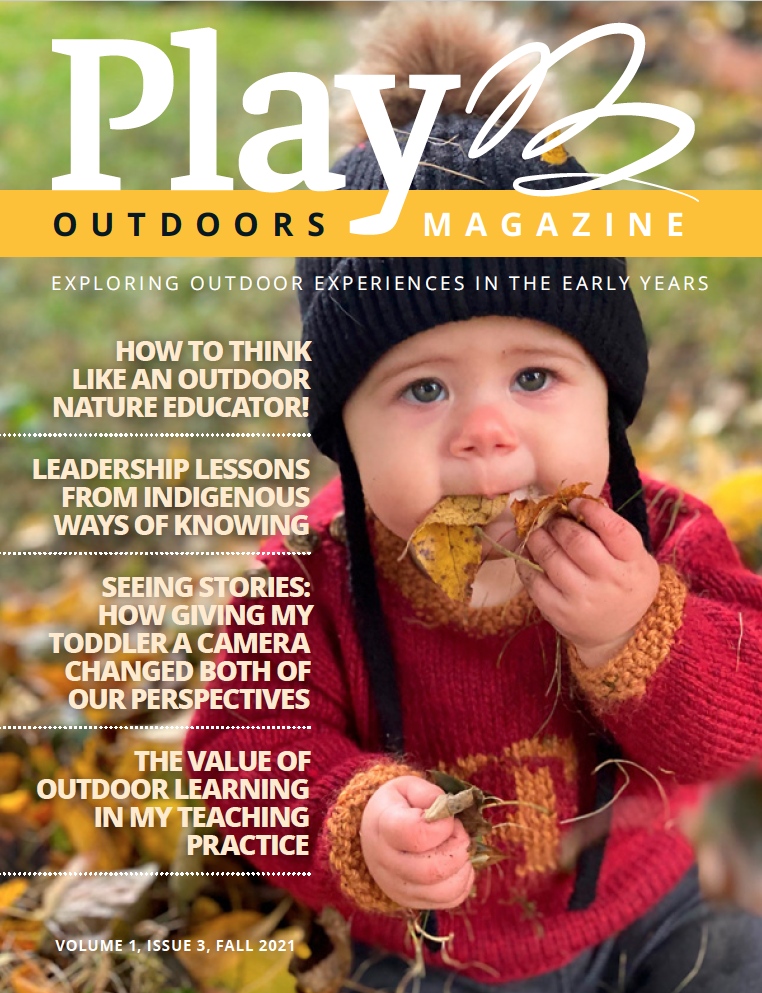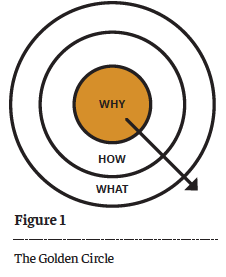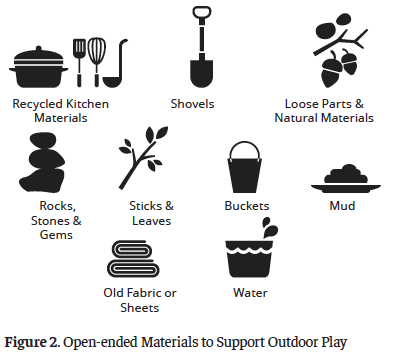
Given that this article focuses on the outdoor natural environment, it is important to acknowledge the land our Discovery childcare centre is situated on. “This land was occupied by the Huron-Wendat Nation. Huron was a name given by the French meaning “boar’s head” in reference to their hairstyle.
Wendat is how they called themselves meaning the “People of the Island.” The Huron Wendat families and strong clans were guided by great diplomatic tradition and their ability to achieve compromise.” This is a brief acknowledgement of the land that we are situated on, and we encourage you to investigate the history of the land where you reside.
Imagine a place where children spend their days developing positive relationships with the natural world. Imagine where they explore with curiosity and joy. Imagine where they share ideas, experiment, try, fail, and try again. Think about where and how educators share in the children’s wonder and discovery. Imagine places where children might interact with materials found in nature and become thoughtful stewards of the earth we share. This is the type of world we are inspired to create for and with children. If this sounds like the spaces that you aspire to be a part of and feel like there are more barriers than possibilities, continue reading!
START WITH WHY AND THE REST WILL FALL INTO PLACE
We believe that being with children in beautiful, natural environments is more than the space and materials…it’s a way of being. Regardless of your space, you can connect children with the natural world. We have spent time engaging with hundreds of educators from all over Ontario with all types of outdoor spaces; from extremely limited to very robust, and our message is the same: nature is everywhere. When we pay attention to our surroundings, we will find nature.
Much research has shown us that children thrive in beautiful, outdoor, natural environments (Dietze & Kashin, 2019; Louv, 2014). For us, we are on a mission to bring a nature connection to as many children, families, and educators as possible through sensory experiences and observations of outdoor environments. We believe that children deserve regular and repeated access to beautiful, natural environments and our values of respect, relationships, curiosity, and nature connection drive everything that we do. If you are curious about taking the leap, we encourage you first to look at the value statements you hold about what children deserve.
We are inspired by the work of Simon Sinek (2009) and his perspective on Starting with Why and the Golden Circle. His work has motivated us to always start with “WHY” as outlined in Figure 1. Sinek identified that, “When most organizations or people think, act or communicate they do so from the outside in, from WHAT to WHY. And for good reason — they go from the clearest thing to the fuzziest thing. We say WHAT we do, we sometimes say HOW we do it, but we rarely say WHY we do WHAT we do” (Ranadive, 2017, p. 1).

Sinek’s framework to leadership is based on the golden circle as outlined in Figure 1.1 (Ranadive, 2017, p. 1). Sinek identified that it is important to examine WHY first. For us, this means each time we engage in a new idea or process, we begin by asking and exploring the WHY – why we do what we do. Then we can focus on how and what we do to live into these values and dispositions.
HOW USING THE GOLDEN CIRCLE GUIDES OUR PRACTICE
Our licensed childcare centre known as Discovery, serves children aged six months to 12 years of age. Since 1998, we have been committed to connecting children, educators, and families to the natural world. Drawing upon research rooted in thinkers such as Jon Young, Richard Louv and Ellen Sandseter, as well as reflection, and deeply held values, we are continuously evolving and developing the outdoor spaces to support children’s sense of wonderment and intrigue.
Discovery is fortunate to have two beautiful acres of land that we use to co-create spaces and places with and for the children. Although we recognize that many early learning and childcare programs do not have an abundance of space, we believe that it is possible for all children to have regular and repeated access to natural, beautiful, outdoor environments. Our space currently includes: a mud kitchen, fire pit, ropes area, grassy fields, and forested areas.HOW USING THE GOLDEN CIRCLE GUIDES OUR PRACTICE
No matter the space, educators benefit from being inspired to think about the conditions and possibilities within the environments created for and with young children. When educators are inspired to listen to children, observe and imagine spaces in new ways, anything is possible. It is not about the location; rather it is about stopping, looking, listening, and connecting with nature and place. The more we pay attention to our surroundings, the richer the discoveries. Imagine your outdoor space – then think about what you might discover if you look up, look down, or get on the ground to see your space from that angle. What new discoveries might you make?
Over time we have learned to create conditions for children to connect to nature and our space. As educators, we have:
• engaged in workshops to empower and connect our educators to the Forest School ethos;
• been empowered by hands on learning, in program training around risk assessments, fire and tool use, and in a variety of professional development opportunities that are connected to nature pedagogy; and
• added materials and spaces to our environments such as: fire area, ropes area, mud kitchen, organic gardens, etc.
REMEMBER… IT’S NOT ABOUT THE STUFF
Reflecting upon values and beliefs about children and nature helps educators connect what strategies and materials could be used to support children’s curiosity and achieve identified goals. Regardless of whether you have a parking lot playground or two acres of forested space, the goals of connecting children to nature is possible. Think about the open-ended materials that might be placed in the space to support triggering children’s curiosity and intrigue. As outlined in Figure 2, there is an array of open-ended materials that can be placed in the outdoor space to support children’s explorations and outdoor play

CONSIDER THE FOLLOWING:
• What is your WHY? Why do you want to integrate particular materials or potential experiences into your space? Once you know your “why”, it is so much easier to achieve your goals and aspirations.
• What gifts within your community might you leverage?
• What types of new learning might you or colleagues require to extend and leverage skills such as: risk benefit assessments, connections to learning outcomes, nature pedagogy and what is meant by the forest school ethos?
• What do you know about your legislation and governing bodies? How do your consultants become a resource that you can collaborate with and always be curious to co-learn together? And remember this question whenever you are encountering a roadblock: Can you please show me where this rule is in the legislation?• What might you do to start small? What might simple additions be each year?
• What changes might you make with a limited budget? Consider what you can safely source from thrift stores and donations from families (i.e. pots and pans, tires).
• How might you connect with like-minded professionals in communities of practice? Co-constructing ideas and engaging in change processes with colleagues in your community who have a similar mission increases the depth of problem solving and thinking outside the box.
CONCLUSION
Children belong in and with nature. They should be provided with opportunities to have time and space to discover nature in their outdoor spaces. Educators have a significant impact on connecting children to nature. The more educators examine their values, start with exploring the “why” and recognize that all outdoor space has natural attributes, new opportunities are extended to children. Open the door… look… think… and image the value to children experiencing their space and place.
References
Dietze, B., & Kashin, D. (2019). Outdoor and nature play in early childhood
education. Pearson Canada Incorporated.
Louv, R. (2014). Prescription: Nature. Habitat Australia, 42(2), 10-11. Ranadive, A., (2017). The power of starting with why. Retrieved from https://
medium.com/leadership-motivation-and-impact/the-power-of-starting-with-why-f8e491392ef8.
Sinek, S. (2009). Start with why: How great leaders inspire everyone to take action. Penguin.
Jessica Holder RECE, BSc, Forest School Practitioner & Karen Eilersen RECE, Forest School Practitioner
Jessica Holder Jessica Holder (RECE, BSc, Forest School Practitioner) has been passionately committed to the field of Early Childhood Education for over a decade. She is the Pedagogical Leader at Discovery Child Care Centre where she works collaboratively with educators to reflect on their pedagogical choices and to grow the programs they co-construct with children and families.
Karen Eilersen – Karen Eilersen (RECE, Forest School Practitioner) is the founder and Director of Discovery Child Care Centre: one of Ontario’s very first licensed childcare centres that is also a certified Forest and Nature school, founded in 1998. She has earned international acclaim for her work in green childcare practices and is a pioneer in terms of advancing the Forest and Nature school concept here in Canada.
DOWNLOAD A COPY of this article.
